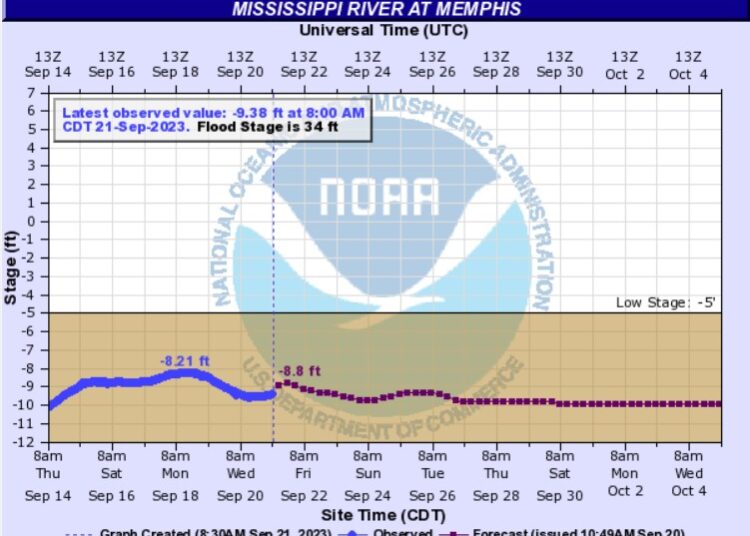Barge rates for moving grain on the Mississippi continue to climb with no signs of significant increases in water levels.
At 8.2 feet below base level, the Mississippi at Memphis, Tennessee, on Wednesday was starting to approach some of the worst levels of late October 2022, which was considered a crisis.
The grain transport cost indicator published each Thursday by the U.S. Department of Agriculture climbed to 529 for the data published that day. The indicator is a percentage of a base-year-100 figure calculated off costs in 2000.
A week earlier, the barge cost indicator for shipping grain was 466. It was 425 a week before that and 221 on Aug. 23, meaning it has more than doubled in about a month.
Not surprisingly, the increase in rates is coming as the number of barges moving on the river has been falling. In the week ending Sept. 16, the USDA report said barge movements hauling grain totaled 129,900 tons of grain. That was down 25% from the prior week and 38% from the same period in 2022, when drought also was slowing shipping on the river.
Translating that into barges, 82 barges moved downriver, a decline of 25 in just one week, the grain shipment report said.
Other USDA comments on the low water levels came mostly from data supplied by the American Commercial Barge Line, which publicly lists restrictions on barge shipments if low water requires reductions.
In its update on shipping conditions published Thursday, American Commercial said barge shipments fell to 28% of capacity for northbound shipments from the Gulf of Mexico to Cairo, the southernmost point in Illinois, where the Ohio River feeds into the Mississippi, and were cut to 24% for southbound movements from Cairo to the Gulf.
Among other restrictions American Barge reported:
The size of the barge shipments has been reduced to five-wide barges from Cairo to Lake Providence, which is in Louisiana. That is a 17% to 38% reduction in tow size, with the exact size of the reduction depending on the horsepower of the tug boats. From Lake Providence to the Gulf, the tow size is six widths. A full tow often is seven barges across.
There have been vessels grounding in the river. There are points where the channel is only 9 feet deep, creating those groundings.
Transit delays might be anywhere from 48 to 72 hours.
Loading drafts out of St. Louis, as well as on the Illinois River and what American Commercial called the “mid Mississippi” have been reduced by 15%.
More articles by John Kingston
Debt rating agencies mostly positive on Forward Air’s acquisition of Omni
BNSF, truck drivers reach settlement in Illinois digital fingerprinting lawsuit
Trucking numbers in BMO earnings again show weakening credit performance
The post Barge rates to move grain rise anew amid low Mississippi water levels appeared first on FreightWaves.














